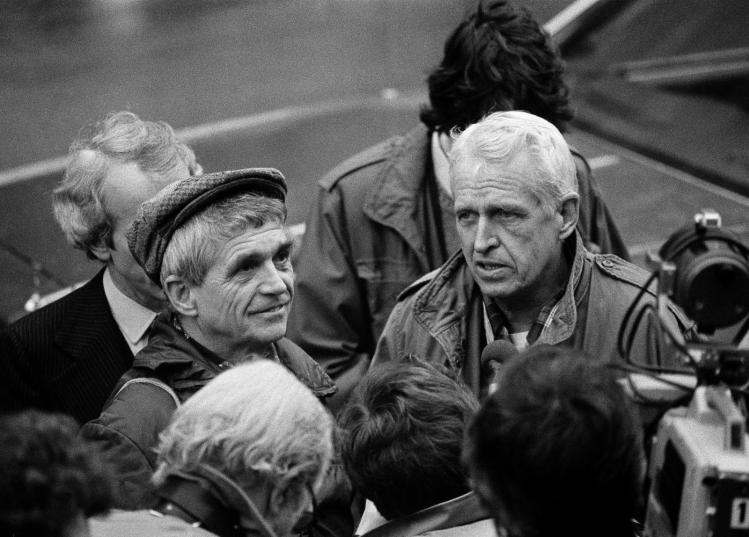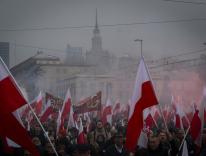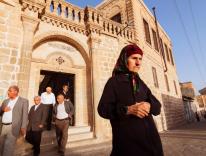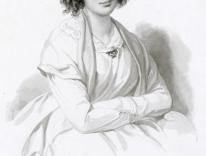
On November 27, 1970, in front of a sparsely attended subcommittee hearing of the all-important Senate Committee on Appropriations, J. Edgar Hoover, the longtime head of the FBI, testified in support of his request for an extra $14.5 million in funding. Buried within his twenty-seven-minute statement, which painted a grim picture of an agency overwhelmed by domestic terrorist plots, was a key revelation that would send the press into a frenzy within hours.
One of the most pressing threats, Hoover warned, came from a “militant group” of “Catholic priests and nuns, teachers, students, and former students” opposed to the war in Vietnam. He claimed they were committing “acts of violence” in protest. “The principal leaders of this group,” he continued, “are Philip and Daniel Berrigan, Catholic priests who are currently incarcerated…for their participation in the destruction of Selective Service Records in Baltimore, Maryland, in 1968.” According to Hoover, the Berrigans’ group was planning “to blow up electrical conduits and steam pipes serving the Washington, D.C. area,” and was also “concocting a scheme to kidnap a highly placed Government official.”
After he concluded his testimony, Hoover’s aides distributed dozens of printed copies of his statement to congressional reporters. By then, he’d reigned over the FBI for nearly half a century, building it up from a nondescript, toothless government agency into a mammoth shadow institution, one that had infiltrated virtually every realm of civil society. Hoover masterfully worked the media for the Bureau’s ends—and on occasion, for his own personal agenda. The next morning, seemingly on cue, the New York Times ran a front-page story titled, “F.B.I. Reports Plot by Antiwar Group to Kidnap U.S. Aide.” Countless newspapers reported the story that day as the hysteria-fueled rumors about the possible target of the radical Catholics’ conspiracy. The morbid intrigue must have delighted Hoover, whose request for additional funds sailed through the approval process.
Within months, the Berrigans’ “target” would be disclosed to the American public: Henry Kissinger. Then serving as President Nixon’s national security advisor, Kissinger—who died on November 29, 2023—had risen in just two years from an obscure, albeit respected foreign-policy academic advising Nelson Rockefeller’s floundering 1968 presidential campaign to one of the most powerful men in the country. And while the world wouldn’t learn the full scope of Kissinger’s unilateral authority for decades (we probably still don’t have a complete picture of it), it was well known that he exercised considerable autonomy in directing American violence in southeast Asia.
Hoover’s announcement marked the start of an important—and now largely forgotten—episode that shaped the trajectory of both antiwar politics and twentieth-century Catholic politics for years to come. The Harrisburg Seven trial revealed the depth of the federal government’s commitment to suppressing the antiwar effort. But it also gave the Berrigans and their movement of nonviolent civil disobedience their most visible platform, introducing millions of Americans to their unique mode of political struggle. As American foreign-policy institutions progressively absorbed the ethos of permanent military adventurism, as symbolized by Kissinger, the Berrigans’ lessons never faded from relevance. Indeed, they’re arguably more important today than ever before.
The Berrigan brothers’ idiosyncratic engagement with the world bucked the norms of both the institutional Church and American society. In 1965, Daniel’s antiwar advocacy landed him in South America, where he had been sent for three months into quasi-exile by Cardinal Francis Spellman, who served as archbishop of New York from 1939 until his death in 1967. Politically, the Berrigans rejected the violent practices espoused by certain segments of the New Left, such as the Weather Underground, and opted instead for methods of nonviolent civil disobedience.
The Berrigans situated themselves in a long lineage of Catholic activists fighting injustice, a tradition dating back to Jesus Christ himself. Figures such as Dorothy Day and Thomas Merton served as more immediate inspirations, though the Berrigans’ willingness to break into draft-board offices and destroy draft files alienated some of the more orthodox pacifists affiliated with the Catholic Worker movement. Still, they all saw themselves as allies with the same purpose—halting the American-led slaughter of civilians in Southeast Asia.
The antiwar priests had been targets of the FBI since the mid-1960s—and especially since their first draft-board raid in 1967. The Baltimore Four, led by Philip that October, brought the national spotlight onto this insurgent strand of Catholic antiwar activism. They justified their call for an immediate end to American involvement in Vietnam by appealing to the gospels and to the life of Jesus Christ. In May of 1968, both brothers raided another draft-board office in Catonsville, Maryland. Their trials dragged on for nearly two years, and they were finally set to begin their sentences on April 9, 1970. But on that day, neither reported to prison.
In the following weeks, hordes of FBI agents tried to track the priests down. Philip would be caught after twelve days, but his older brother Daniel continued to evade authorities for months. He would surface at antiwar rallies and meetings across the Northeast, occasionally even stopping by to deliver a sermon at a church with a sympathetic pastor. A vast network of antiwar advocates, student activists, academics, and clergy members sheltered him from FBI detection. On multiple occasions, federal agents narrowly missed Berrigan, sometimes by just a few minutes.
When he appeared in public, he would regularly mock the FBI for its incompetence. For its part, the FBI committed hundreds of agents to chase him down, even vaulting him into the Bureau’s list of the ten most-wanted fugitives. News of the priest’s daring bolstered the Berrigans’ notoriety—and, in the process, increased awareness of the Catholic antiwar cause. But to the famously thin-skinned Hoover, Daniel and his band of renegade Catholics were humiliating the FBI. Hoover, growing old and more paranoid than ever about his slipping power, felt he needed to take drastic action to reassert his authority.
In his attempt to take down the Catholic Left, Hoover turned to a tried-and-true strategy: he deployed a network of informants to infiltrate and gather intel on the group, with the hopes of turning up incriminating information. Philip, who originally began his sentence in 1970 at a federal prison in Lewisburg, Pennsylvania, began smuggling letters in and out of the prison through another inmate named Boyd Douglas, who was allowed to exit the prison to take classes at Bucknell University. Unbeknownst to Philip, Boyd was cooperating with federal authorities, copying and forwarding every letter directly to the FBI.
Most letters from Philip were innocuous love notes to a fellow Catholic activist, Sr. Elizabeth McAlister. Philip and Elizabeth had fallen in love and secretly deemed themselves married in 1969. (After the trial revealed their relationship, Philip left the priesthood and Elizabeth her religious community in order to start a family, while devoting their lives to social and political activism.) But in one letter to Philip, Elizabeth mentioned a plan “to kidnap—in our terminology make a citizen’s arrest—someone like Henry Kissinger.” Kissinger would be a perfect target given “his influence as a policy maker,” but the fact that he wasn’t an official cabinet member meant that he’d be less protected than others. Conveniently, he was a notorious playboy, who often eschewed security in his off hours. Kissinger was, in Elizabeth’s words, “anxious to have unguarded moments where he could carry on his private affairs—literally & figuratively.” The goal of a citizen’s arrest was simple: “To issue a set of demands, e.g. cessation of [the] use of B 52s over N. Vietnam, Laos, Cambodia, & release of political prisoners.”
Kissinger’s national prominence goes unmentioned in Elizabeth’s letter, but it’s critical for understanding his place in the imagination of the Catholic Left. In 1970, Kissinger wasn’t merely an influential policymaker or some anonymous D.C. bureaucrat. Within weeks of assuming his post in the Nixon administration, he graced the cover of Time magazine—where he’d appear fourteen more times before leaving the government. He vigorously cultivated relationships with journalists across the country, spinning stories at all hours of the day and night, charming pundits, and strategically leaking information to ensure his name remained in the news. His romantic exploits became regular tabloid fodder, so much so that by late 1970, Kissinger was virtually a household name.
For antiwar activists, Kissinger’s name was synonymous with the American-led destruction in Southeast Asia—and more broadly, with our nation’s imperial bloodlust. Many saw his ascent as having codified the U.S. government’s willingness to commit mass murder in pursuit of its “national interest.” A figure like Kissinger roused the consciences of the Catholic Left, which drew attention to the suffering of civilians in Vietnam, Cambodia, and Laos—as well as to the poor in this country, whose needs were being neglected in favor of massive war investments.
Years later, Philip would write about Kissinger with searing judgment: “Kissinger strutted and fretted his bloody hour. No one could stop him. He wasn’t accountable to the American or Vietnamese people. He had no respect for international law, or the law of God. We were merely talking about one way to hold him accountable for his crimes against humanity.”
Hoover’s decision to disclose the Catholic activists’ plot at the appropriations subcommittee hearing incensed his subordinates. They knew that the federal government didn’t have enough evidence of a concrete conspiracy, but given Hoover’s reckless public announcement, they’d have no choice but to charge the group. On January 12, 1971, a month and a half after Hoover’s subcommittee testimony, Attorney General John Mitchell announced the indictment of six activists, including Philip and Elizabeth (Daniel was named as an unindicted coconspirator). In the coming months, two more activists would be added to the indictment, though one of them would soon be removed, leaving the final group at seven.
The antiwar movement responded with force to the Harrisburg Seven indictment. It quickly became a cause célèbre of the American liberal left. The notion that a group of peaceful Catholic activists conspired to bomb government buildings and kidnap a member of the Nixon administration struck many Americans as absurd, even if they weren’t necessarily sympathetic to the antiwar effort. But the sensationalism of the charges made the Harrisburg Seven case a fixture across news programs and newspapers throughout the early 1970s.
With little evidence of a firm conspiracy in hand, federal prosecutors embarked on a fishing expedition for additional proof to substantiate their charges, issuing subpoenas to anyone with the slightest connection to the Catholic resistance network. But these efforts would ultimately fall short: by the time the trial commenced in the spring of 1972, the Department of Justice couldn’t make a convincing case that the conspiracy existed in any real sense. The only evidence in their possession was the intercepted letter, coupled with the word of Boyd Douglas—and the latter quickly proved to be unreliable, as his testimony completely unraveled under the cross-examination of the defense team.
The trial ended in a hung jury on all major charges. Only Elizabeth and Philip received minor convictions for smuggling letters into and out of prison, but even those would be dropped upon appeal. All major news outlets covered the trial closely, but the press’s fascination with the Catholic resistance quickly fizzled out after the verdict was announced. Soon, the entire ordeal—particularly the absurd notion of “kidnapping Henry Kissinger”—became a punchline. Kissinger himself never seemed to take any threat to his safety seriously. Upon hearing about the plot, he remarked to the press that “sex-starved nuns” were after him, a comment for which he was later forced to apologize.
The Catholic Left never coalesced into any organization, nor did it ever enjoy much support from mainstream Catholic institutions. In its heyday, it boasted several thousand committed activists, a minuscule minority among the tens of millions of Catholic Americans, many of whom felt little sympathy for the subversive activities led by the Berrigans. But even if most Catholics didn’t approve of draft-board raids, no one could deny the courage and conviction of the Catholic Left. They compelled the nation to confront the violent inhumanity at the core of the U.S. campaign in Southeast Asia. They laid bare the real stakes—political, social, and theological—of America’s military adventurism.
But the Catholic Left’s gifts to the antiwar movement went beyond mere discourse and consciousness. Its practices of direct action inspired dozens of draft raids throughout the late 1960s and early 1970s. Together, these destroyed hundreds of thousands of draft files, sabotaging the bureaucratic administration of the war. Perhaps most significantly, the organizers of the 1971 Media, Pennsylvania, FBI burglary drew directly from the Berrigans and the Catholic Left. The group cited the Berrigans as an influence when they broke into an FBI office in Media and stole more than a thousand classified FBI files. The files would soon be published by the Washington Post, and divulged some of the Bureau’s most intensely guarded secrets, among them the infamous COINTELPRO program. The fallout of the Media burglary led to major reforms within the institution, and marked one of the most embarrassing and consequential episodes in FBI history.
Kissinger’s vision of America and its role in the world triumphed through the end of the twentieth century, and into the twenty-first. That vision gives our nation license to commit wanton violence in the name of “realpolitik,” no matter how many thousands of innocent civilians must be butchered for its ends. The right of the United States to kill people in faraway lands, often secretly, in pursuit of national security is a hallmark of Kissinger’s America, and it endures as a key principle of the American foreign-policy consensus today.
The Berrigans’ Catholic Left understood this principle. They saw the ways in which both Democrats and Republicans reproduced war, and they saw that, in this sense, the American electoral system was largely immune to any mass political pressure. For them, nonviolent direct action became an important mode of democratic resistance, circumventing the institutions captured by the war machine and directly targeting the operational sources of the war. Even more, their resistance grounded itself in a mutually reinforcing relationship between faith and political action: faith supplies an inexhaustible reserve of conviction and hope, while political action puts central commitments of Christian faith into practice.
Today, bombs rain down on a captive population in Gaza. At least twenty-five thousand Palestinians have been killed, most of them women and children. Despite unprecedented demonstrations against the slaughter and an outpouring of public pressure on elected officials, Washington remains locked into its present course of action—defending and funding war crimes on a massive scale. Our nation’s foreign-policy decision-making, soaked in Kissingerian realism, seems to require this massacre of civilians, no matter our rhetorical commitments to human rights.
As millions mobilize against the ongoing bloodshed, they have turned to the methods the Berrigans and their allies used: nonviolent direct action and civil disobedience. And activists have yoked their protests to Christian, Muslim, and Jewish faith traditions (among others) in powerful and fascinating ways. These antiwar protesters are contesting Kissinger’s false vision of America’s rightful place in the world. Even if most of them couldn’t tell you who the Berrigan brothers were, the Catholic Left’s shadow looms large in this struggle.
Please email comments to [email protected] and join the conversation on our Facebook page.
Share
Previous Story
The German Synod & Francis’s Legacy
Next Story
Ireland Joins the World—and Leaves the Church


